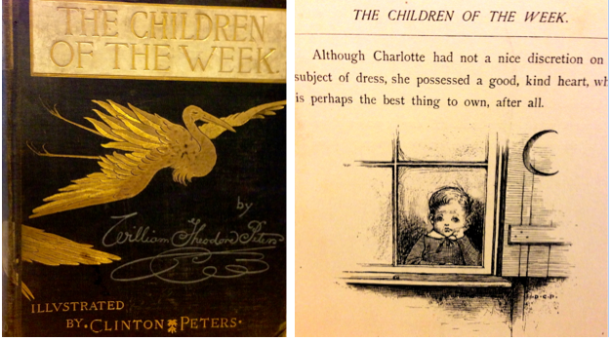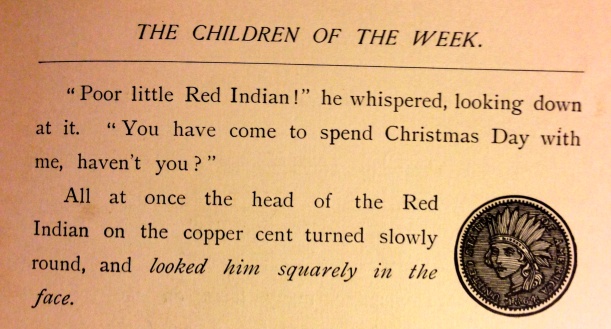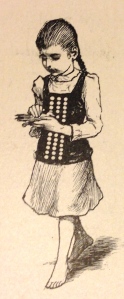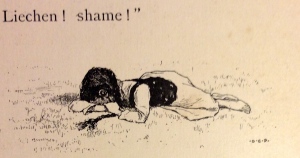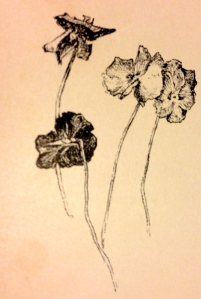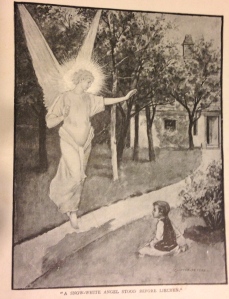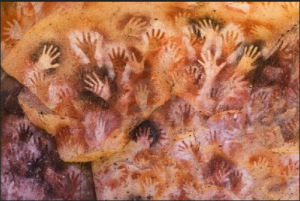“Man is in his actions and practice, as well as in his fictions, essentially a story telling animal.”
~Alasdair MacIntyre, After Virtue: A Study in Moral Theory, 1981
Storytelling is our birthright – we’re born with it, we crave it, we use it to make sense of our world. It was our first instinct in the caves to draw narrative pictures on the walls with whatever materials would make a mark.
I consider myself first and foremost a storyteller, using various mediums and venues to get my message across. That’s why I chose this topic to explore as part of my Social Media class at Drury University. In his paper “Narration as Human Communication Paradigm: The Case of Public Moral Argument , Walter R. Fisher explores what the human propensity for storytelling means in society.
If I understand him correctly, Fisher puts forth the idea that it is narrative – words/deeds that have sequence and meaning for those who live, create or interpret them – only have meaning in a storytelling context. Further that public moral argument only takes on sensible meaning in a cultural context understood by the layperson and the experts engaging in the conversation. To make sense and meaning of ordinary experience, stories are needed. “The ground for determining meaning, validity, reason, rationality and truth must be a narrative context: history, culture, biography and character. Facts and experience need some narrative that can bind the facts of our experience together into a coherent pattern. Quoting theologian Goldberg, “The meaning and significance of life in all of its social dimensions require the recognition of its narrative structure.”
Here is a Victorian moral tale that was one of my favorites from childhood. I collect illustrated story books from this era, and inevitably the stories are tragic moral tales that show the reader what will happen if they don’t act in accordance with the mores of the day. This to me is a good example of Fisher’s premise that narratives need to have some fidelity to human truth, and create a relationship in the readers’ mind to the consequences of their own behavior.
In Children of the Week, the story weaves around an copper Indian Head penny given to a little crippled boy by a shop girl. The penny comes to life and tells the boy the tales of all the children of the week. You’ll see what an influence this story could have on an impressionable young mind. And how the moral of being kind is played out in melodramatic detail.
The Angel and the Pansies: Saturday’s Story
Once upon a time…. there lived a little maid named Liechen, who had a tiny brother called Paul. Now Liechen was an unpleasant girl and nobody liked her. She plagued and tormented every one she knew. Even Baby Paul who was so sweet and gentle that the robins would fly down and eat out of his puggy hands. … even Baby Paul was a miserable baby when ever Liechen undertook to entertain him. She carried him upside down, smashed his toys, interrupted his naps, made him scream, pinched him on the sly, or prevented him from comfortably swallowing his fist.
But Liechen was not allowed to keep her brother very long; for sometimes it happens when we do not value the blessings we possess, they are taken from us.
There came a day when Baby Paul no longer toddled through the flowers in search of robins and sunbeams. The roses in the round cheek turned white and pale; the fringed lids were drawn closely over his clear, blue eyes. They laid a spotless rose on his bosom and all the people wept. Leichen hid her face in the cool grass and wept, and thought bitterly of all the unkind things she had said and done to Baby Paul. But it was too late. The wind, flowers, birds, cat all murmured, “Shame!”
An angel appeared to her and took her to a bed of weeds, saying, “all these are the naughty acts you’ve committed.” When Leichen pushed them aside, she found one purple pansy. “The pansy growing solitary there, is a token of your tears of repentance. No one can enter Paradise until their lives are as sweet and holy as this flower.” The angel told her she had to pull up all the weeds, and “for every good deed you do, a pansy will spring up. When the garden-plot is full of flowers, I will come and bear you hence.”
Leichen was not the same child she had been in days gone by; the flowers of love, pity and compassion were blooming in her heart. She did good works, mended the broken wings of birds and such, until one day the angel reappeared. Taking her to the garden, the angel pointed to the mound, “Look! The pansies are all grown now.” The angel folded her close, and took her to dwell with the Baby Paul in Paradise.
What a dramatic telling. I was always filled with childish emotion when I’d read this, or it was read to me, and I’d gaze at the pictures. I wanted to be a good girl, so I could go to Paradise too, and play with Baby Paul. Who wouldn’t?? I even copied many of the illustrations in my longing to be part of this quaint storybook.
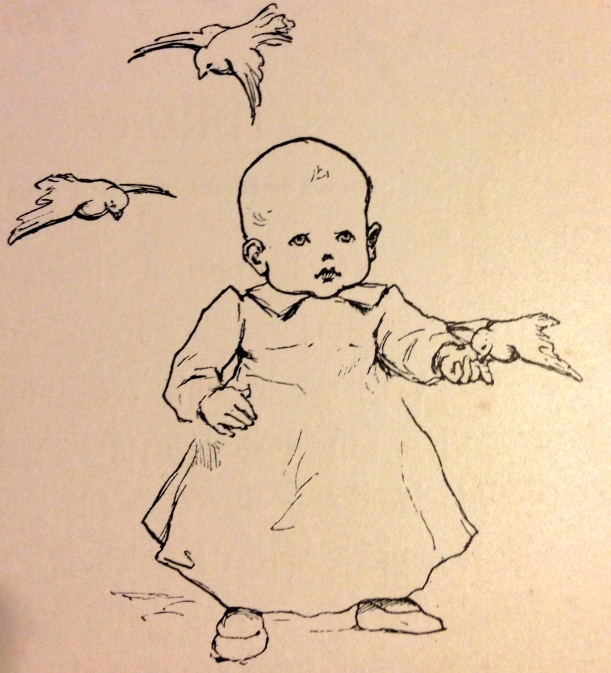
Baby Paul who was so sweet the sunbeams loved to play in his golden locks & robins would ear out of his puggy hands.
To complete this theme, I’ll share with you some of the ideas expressed by Fisher that I resonate with, and I paraphrase. His research reinforces many common themes I find today going around the circles of Social Media storytellers. His findings give me hope, make me realize my path as a storyteller links me in tiI think they speak for themselves, with little explanation. If you agree, or find one compelling, let me know in your comments.
- The idea of human beings as storytellers indicates the general form of all symbol composition: it holds that symbols are created and communicated ultimately as stories meant to give order to human experience and to induce others to dwell in them to establish ways of living in common, in communities in which there is sanction for the story that constitutes one’s life.
- Life is an unending conversation that goes on before we were born; we enter, put in our oar, converse, depart, and the conversation goes on beyond our life.
- Dramatic stories constitute the fabric of social reality, constructions of fact and faith. I propose to add the metaphor of homo narrans to represent the essential nature of human beings. The world is a set of stories which must be chosen among to live the good life in a process of continual recreation.
- Narratives enable us to understand the actions of others because we all live out narratives in our lives and because we understand our own lives in terms of narratives.
- Narrative whether written or oral is a feature of human nature; it crosses time and culture, a universal cultural activity embedded in the very center of the social drama.
- The most compelling persuasive stories are mythic in form. The most engaging stories are mythic, the most helpful and uplifting stories are moral. Per John Gardner, “moral action is action that affirms life.”
- The truly “good” story elevates the humanity of persons to the profoundest moral and metaphysical level the world has known – such as the cosmologies of Lao-tsu, Buddha, Christ, Zoraster, Mohammed. A “bad” story example is Hitler’s Mein Kampt which demeans and denies the humanity of certain persons. “Good” stories reaffirm the human spirit as the transcendent ground of existence. A good story example is the narrative that proposes that people learn these truths: “Life is fullest when one loves and is loved; death is real; and maturity is achieved by accepting the reality of death.” We learn these truths by dwelling in the characters of the various stories, like the Iliad and the Odyssey.
Video on Human Communication, Latrobe University, Australia
The unity of human life is the unity of the narrative quest.
And that quest is for the “good life” for all persons.



